Recent Posts
Restoring Fire-Damaged Roofing and Gutters: Expert Insights from SERVPRO
12/18/2024 (Permalink)
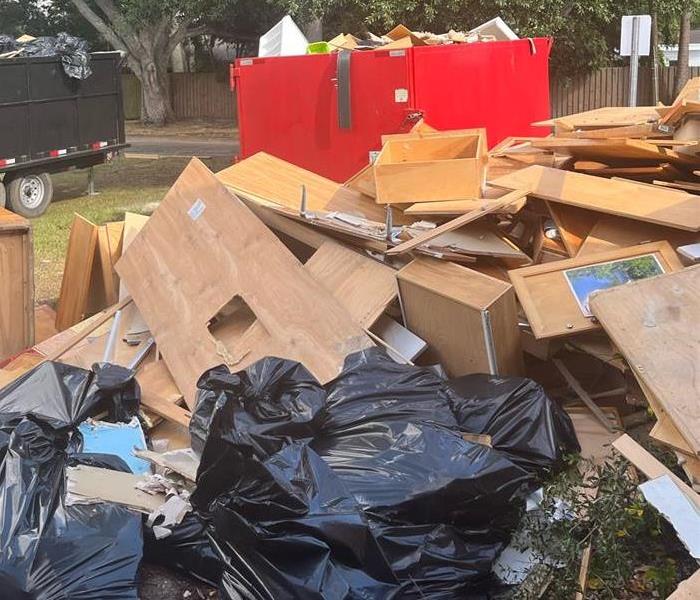 Dive into the expert steps for restoring roofing and gutters after a fire, helping you understand why professional restoration is essential.
Dive into the expert steps for restoring roofing and gutters after a fire, helping you understand why professional restoration is essential.
Fires cause extensive damage to homes, and while interior damage may be the most noticeable, the roof and gutters often suffer significantly as well. The roof is a vital protective barrier for your home, and damage to it or your gutter system can lead to further complications if not addressed quickly. SERVPRO® is an expert in fire damage restoration, offering comprehensive services to restore fire-damaged roofing and gutters. In this blog, we’ll dive into the expert steps for restoring roofing and gutters after a fire, helping you understand why professional restoration is essential.
The Impact of Fire on Roofing and Gutters
When a fire occurs, roofing materials and gutters are highly vulnerable to heat, flames, and smoke. Flames can burn through shingles, underlayment, and supporting structures, while smoke and soot may penetrate deeper, causing unseen structural issues. Gutters, often made of metal, can become warped or clogged by debris and melted materials. Additionally, water used to extinguish the fire can worsen the damage, weakening the structure further.
According to the National Fire Protection Association (NFPA), an average of 353,100 home structure fires were reported annually between 2015 and 2019, causing extensive property damage and leaving many homeowners in need of professional restoration services. When it comes to fire-damaged roofs and gutters, prompt and expert attention is crucial to prevent further deterioration.
How to Restore Fire-Damaged Roofing and Gutters
1. Initial Inspection and Damage Assessment
Before any restoration work begins, a thorough inspection of the roof and gutters is necessary to determine the extent of the fire damage. SERVPRO professionals inspect for structural integrity, looking for burnt or weakened roofing materials, melted or damaged gutters, and areas where soot and smoke may have penetrated. This assessment guides the restoration process, ensuring that no hidden damage is overlooked.
2. Roofing Repair and Replacement
Depending on the severity of the fire damage, roof restoration may involve minor repairs or complete replacement of the roofing materials. Common roofing materials, such as asphalt shingles, may have melted or caught fire during the blaze. SERVPRO professionals will remove and replace damaged shingles, ensuring that the underlayment and support structures beneath the shingles are also intact. If necessary, sections of the roof structure, such as the decking, may be replaced to maintain the roof’s strength and stability.
3. Soot and Smoke Removal
Even if the roofing materials appear intact after a fire, smoke and soot may have penetrated into the roof’s structure. These residues can weaken the materials over time. SERVPRO uses specialized cleaning methods to remove soot and smoke particles from both the surface and underlying structures. This process not only restores the appearance of the roof but also ensures that harmful fire residues are eliminated.
4. Gutter Repair and Cleaning
Fire damage can cause gutters to warp, clog, or become detached from the roof. SERVPRO professionals inspect the gutters for any visible damage and remove debris such as ash, melted materials, and dirt. If the gutters have sustained significant damage, such as warping from extreme heat, they may need to be replaced to ensure proper water drainage.
5. Water Damage Repair
In many fire incidents, water used to extinguish the flames causes additional damage to roofing and gutter systems. Saturated roofing materials and gutters can lead to long-term issues like mold growth, rot, and rust if not properly addressed. SERVPRO ensures that any water-damaged areas are dried and treated to prevent future issues, preserving the integrity of the roof and gutter system.
6. Final Inspection and Restoration
Once all repairs and cleaning are complete, SERVPRO conducts a final inspection to ensure that the roof and gutters are fully restored and functioning as they should. This step involves checking for proper water flow through the gutters, ensuring the roof is watertight, and verifying that any fire-related damage has been thoroughly addressed.
Why Hire SERVPRO for Fire-Damaged Roof and Gutter Restoration?
Restoring fire-damaged roofing and gutters is not a simple DIY project. Here’s why you should rely on SERVPRO for expert restoration services:
- Specialized Expertise: SERVPRO has the knowledge and experience to assess the full extent of fire damage, ensuring that every aspect of the roof and gutter system is addressed.
- Professional Equipment: SERVPRO uses advanced tools and techniques to clean, repair, and restore fire-damaged roofing materials and gutters effectively.
- Comprehensive Restoration: From soot and smoke removal to repairing structural damage, SERVPRO provides a complete restoration service, ensuring your roof and gutters are as good as new.
Key Takeaways for Restoring Fire-Damaged Roofing and Gutters
- Start with a professional inspection to assess structural damage and hidden issues caused by fire.
- Replace damaged shingles, underlayment, and supporting structures as needed.
- Remove soot and smoke from roofing materials to prevent long-term deterioration.
- Repair or replace damaged gutters and clear out fire-related debris.
- Address water damage caused by firefighting efforts to prevent mold, rot, or rust.
Roofing and gutters are critical components of your home’s structural integrity, and prompt, professional restoration is essential to prevent further damage. SERVPRO's team of fire restoration experts is equipped to handle all aspects of roof and gutter restoration, helping you protect your home and restore its functionality after a fire.
For expert fire restoration services, including roofing and gutter repair, contact SERVPRO today!
The Impact of Mold on Indoor Air Quality: Expert Insights from SERVPRO®
11/13/2024 (Permalink)
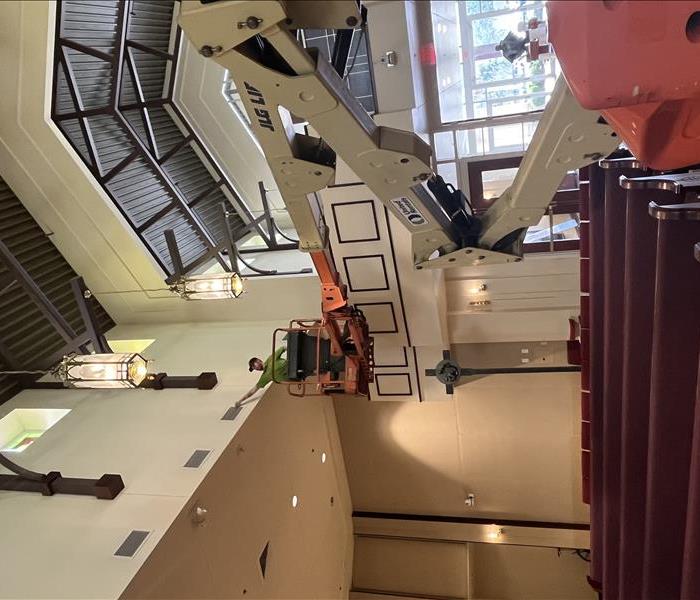 In this blog, we’ll explore the impact of mold on indoor air quality, how mold develops, and expert strategies to improve your home’s air environment.
In this blog, we’ll explore the impact of mold on indoor air quality, how mold develops, and expert strategies to improve your home’s air environment.
Mold is a common household issue in Gainesville, FL, that many homeowners face, especially in areas with high humidity or water damage. While mold is often visible on walls, ceilings, or floors, its presence also significantly affects the quality of the air inside your home. The air you breathe is just as important as the surfaces you see, and mold can compromise indoor air quality in ways that aren’t always obvious. In this blog, we’ll explore the impact of mold on indoor air quality, how mold develops, and expert strategies to improve your home’s air environment.
How Mold Affects Indoor Air Quality
Mold reproduces through microscopic spores that become airborne when disturbed. Once these mold spores are released into the air, they circulate throughout the home, potentially spreading to other areas. This contamination can compromise the indoor air quality, leading to issues with odors, moisture levels, and overall comfort. According to the Environmental Protection Agency (EPA), mold can begin to grow indoors within 24-48 hours of moisture exposure, making it critical to address water damage and high humidity immediately.
Causes of Mold in Homes
Understanding the factors that cause mold growth is essential to preventing it from spreading and negatively affecting indoor air quality. Here are some common causes of mold in homes:
- Water Damage: Leaks from roofs, plumbing, or flooding can introduce moisture into your home, which creates the perfect environment for mold to grow. Even minor leaks that go unnoticed for long periods can lead to mold development behind walls, under floors, and inside ceilings.
- High Humidity: Homes in regions with high humidity or inadequate ventilation are more prone to mold growth. Mold thrives in environments with humidity levels above 60%, and if left unchecked, high humidity can result in the development of mold colonies.
- Poor Ventilation: Inadequate airflow throughout a home can trap moisture, particularly in bathrooms, basements, and kitchens. Without proper ventilation, mold can grow quickly in these areas and affect the air quality throughout the house.
- Condensation: Condensation on windows, pipes, and walls due to temperature fluctuations can result in damp surfaces. If these surfaces aren’t regularly dried, mold can begin to develop and release spores into the air.
How Mold Contaminates the Air
Mold’s ability to release spores into the air is one of the main ways it impacts indoor air quality. When disturbed by movement, air circulation, or cleaning efforts, mold spores become airborne and can spread to other areas of the house. This not only increases the mold problem but also reduces the quality of the air you breathe.
Additionally, mold can produce a musty odor, which is a clear indication of mold contamination in the air. If the air inside your home smells damp or stale, it’s often a sign that mold is present somewhere in your home, possibly in unseen areas like behind walls or under carpets.
Expert Strategies to Improve Indoor Air Quality
Improving your home’s indoor air quality requires addressing mold at its source and implementing long-term solutions to prevent it from recurring. Here are expert tips for keeping mold at bay and maintaining clean indoor air:
- Control Humidity Levels: One of the most important steps to improving air quality is controlling your home’s humidity levels. Use dehumidifiers in moisture-prone areas such as basements, kitchens, and bathrooms to maintain humidity levels below 60%.
- Fix Water Leaks Promptly: Any leaks from plumbing, roofs, or windows should be addressed immediately to prevent moisture buildup. Even small leaks can lead to mold development if not repaired, so regular maintenance is key to preventing mold contamination.
- Improve Ventilation: Proper ventilation is essential for reducing moisture and maintaining healthy air circulation throughout your home. Use exhaust fans in bathrooms, kitchens, and laundry rooms to remove excess moisture and prevent condensation.
- Use Mold-Resistant Products: When remodeling or making home improvements, opt for mold-resistant materials such as mold-resistant drywall and paint, especially in moisture-prone areas. These materials are designed to withstand high humidity levels and prevent mold growth.
- Inspect and Clean HVAC Systems: Your home’s HVAC system plays a crucial role in maintaining indoor air quality. Regularly inspect and clean your HVAC filters, ducts, and vents to prevent mold spores from circulating through your home’s air.
- Professional Mold Remediation: If mold has already begun to affect your home’s air quality, it’s essential to contact mold remediation professionals like SERVPRO®. Our team uses specialized equipment to detect hidden mold, remove it safely, and restore clean air quality in your home.
Trust SERVPRO for Mold Remediation and Indoor Air Quality Solutions
When it comes to mold and indoor air quality, the stakes are high. Addressing mold early is the best way to ensure that it doesn’t spread and compromise the air you and your family breathe. At SERVPRO, our professional mold remediation services are designed to eliminate mold at its source, improve air quality, and provide long-lasting solutions to keep your home mold-free.
With our advanced tools, expert knowledge, and commitment to excellent service, SERVPRO is your trusted partner in restoring and maintaining indoor air quality. Contact us today to learn more about our mold remediation services and how we can help you breathe easier in your home.
Mold has a significant impact on indoor air quality, but with the right prevention and remediation strategies, you can protect your home’s air environment. Don’t wait until mold spreads—take action today to safeguard the quality of your indoor air.
How to Protect Your Home from Flash Floods and Sudden Storms
10/13/2024 (Permalink)
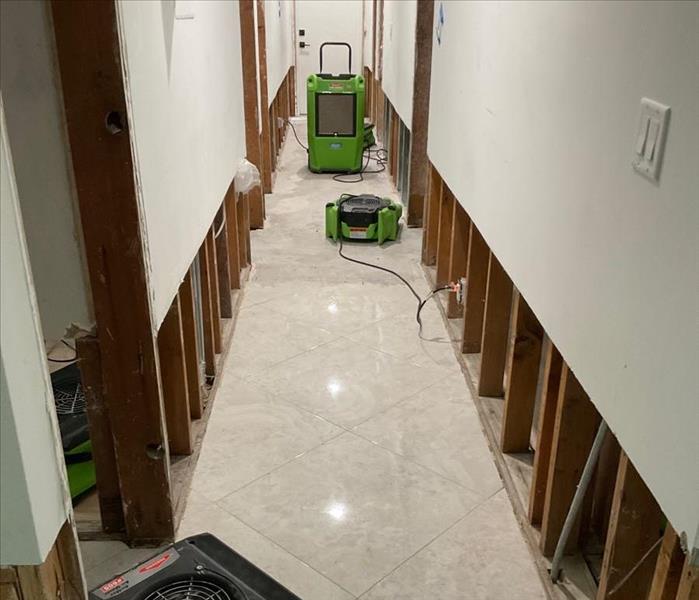 If the worst does happen, remember that SERVPRO of Gainesville West, Alachua County West is just a call away!
If the worst does happen, remember that SERVPRO of Gainesville West, Alachua County West is just a call away!
Gainesville, FL, is known for its beautiful weather, but it’s also susceptible to flash floods and sudden storms. The unexpected weather can cause significant damage to homes, leading to expensive repairs.. Understanding how to protect your home from these risks is crucial for any homeowner. In this blog, we’ll cover essential tips and strategies for safeguarding your property against the dangers of flash floods and sudden storms.
The Risks of Flash Floods and Sudden Storms
Flash floods occur quickly and with little warning, usually due to intense rainfall over a short period. In Gainesville, where heavy rains are common, these floods can happen in a matter of minutes. The National Weather Service reports that flash floods are the leading cause of weather-related deaths in the U.S., making it essential to take these risks seriously.
Is Your Home Vulnerable?
To effectively protect your home, start by assessing its vulnerability to floods and storms. Consider factors such as your home’s location, the elevation of your property, and the condition of your drainage systems.
- Know Your Flood Zone
Gainesville is divided into different flood zones, each with varying levels of risk. Check the Federal Emergency Management Agency flood maps to determine your home’s flood zone. Homes in high-risk areas should take extra precautions and may require flood insurance.
- Inspect Your Drainage System
A well-maintained drainage system is critical in preventing water from accumulating around your home. Ensure that gutters, downspouts, and storm drains are clear of debris and functioning correctly. Poor drainage can lead to water pooling around your foundation, increasing the risk of flooding.
Strengthening Your Home's Defenses
Once you’ve assessed your home’s vulnerability, the next step is to strengthen its defenses against flash floods and sudden storms.
- Elevate Essential Systems
If you live in a flood-prone area, consider elevating critical systems such as your HVAC unit, electrical panel, and water heater. This can prevent damage and keep these systems operational even during a flood.
- Install Flood Barriers
Flood barriers, such as sandbags or flood panels, can provide temporary protection against rising waters. These barriers are particularly useful for protecting entry points like doors and windows, which are vulnerable to floodwaters.
- Seal Cracks and Gaps
Inspect your home for any cracks or gaps in the foundation, walls, and around windows and doors. Seal these openings with waterproof materials to prevent water from seeping in during heavy rains.
- Use Water-Resistant Materials
If you’re renovating or building a home in Gainesville, consider using water-resistant materials. These materials, such as tile or vinyl flooring and treated wood, can withstand exposure to water better than traditional materials, reducing the need for repairs after a storm.
Final Thoughts
Protecting your Gainesville, FL home from flash floods and sudden storms is an ongoing process. By assessing your home’s vulnerabilities and strengthening its defenses, you can significantly reduce the risk of damage. And if the worst does happen, remember that SERVPRO of Gainesville West, Alachua County West is just a call away, ready to help you restore your home to its pre-damage condition.
Florida Gators Partner
9/17/2024 (Permalink)
 SERVPRO as the official 3rd down partner of the Florida Gators.
SERVPRO as the official 3rd down partner of the Florida Gators.
SERVPRO of Gainesville are proud to light up the ribbon and LED boards as the official 3rd down partner of the Florida Gators.
Protecting Your Home from Florida Flash Floods: Prevention and Cleanup
9/11/2024 (Permalink)
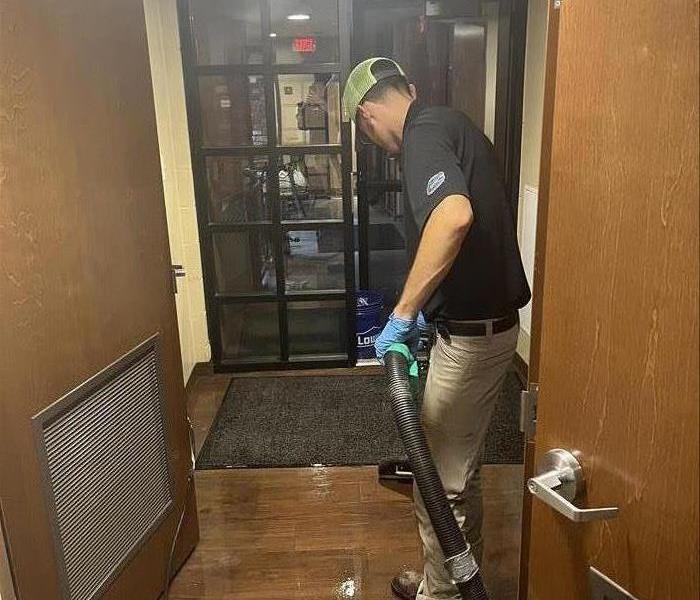 Here's a comprehensive guide on prevention and cleanup to help you stay ahead of Florida's flash floods.
Here's a comprehensive guide on prevention and cleanup to help you stay ahead of Florida's flash floods.
Flash floods can strike suddenly, especially in Florida, where the weather is notoriously unpredictable. As a homeowner, it's crucial to be prepared for these emergencies to protect your property and loved ones. Here's a comprehensive guide on prevention and cleanup to help you stay ahead of Florida's flash floods.
Understanding the Threat of Flash Floods in Florida
Flash floods are a significant concern in Florida due to its flat terrain and frequent thunderstorms. According to the National Weather Service, flash floods can occur within six hours of a rain event, often catching residents off guard. Florida ranks among the top states for flash flood occurrences in the United States.
Prevention: Safeguarding Your Home
1. Elevate and Secure Valuables
Ensure that valuable items and important documents are stored in waterproof containers and elevated above potential flood levels. Consider placing these items on higher floors or shelving units.
2. Maintain Proper Drainage
Regularly inspect and clean gutters, downspouts, and drainage systems to ensure they are free from debris. Proper drainage helps divert water away from your home's foundation, reducing the risk of flood damage.
3. Install Flood Barriers
Flood barriers, such as sandbags or commercial flood barriers, can be an effective line of defense against rising water. Place these barriers around entry points to prevent water from entering your home.
4. Landscape Smartly
Design your landscape to direct water away from your home. Use native plants and absorbent materials that help soak up excess water, reducing runoff and the potential for flooding.
During a Flash Flood: Immediate Actions
Stay informed about weather conditions and heed any warnings from local authorities. If a flash flood warning is issued, move to higher ground immediately and avoid walking or driving through floodwaters.
Cleanup: Restoring Your Home After a Flash Flood
1. Ensure Safety First
Before entering your home, ensure it's safe. Turn off electricity and gas supplies to prevent accidents. Wear protective gear like gloves and boots to avoid contamination from floodwaters.
2. Remove Water and Dry Out
Use pumps, wet vacuums, and dehumidifiers to remove standing water and moisture. Open windows and doors to promote airflow and speed up the drying process.
3. Sanitize and Disinfect
Floodwaters can carry harmful bacteria and contaminants. Thoroughly clean and disinfect all affected areas and items to prevent mold growth and health hazards.
4. Repair and Restore
Inspect your home for structural damage and make necessary repairs. Replace drywall, insulation, and flooring that have been soaked by floodwaters to prevent long-term damage.
Partner with SERVPRO® for Professional Help
Dealing with the aftermath of a flash flood can be overwhelming. SERVPRO offers professional flood damage restoration services, ensuring your home is restored quickly and efficiently. Our team of experts is equipped to handle all aspects of flood cleanup, from water removal to complete restoration.
Stay prepared and protected from Florida's flash floods. With the right prevention measures and a reliable cleanup partner like SERVPRO, you can safeguard your home and peace of mind.
Why Hiring Certified Professionals is Crucial for Fire Damage Restoration
8/14/2024 (Permalink)
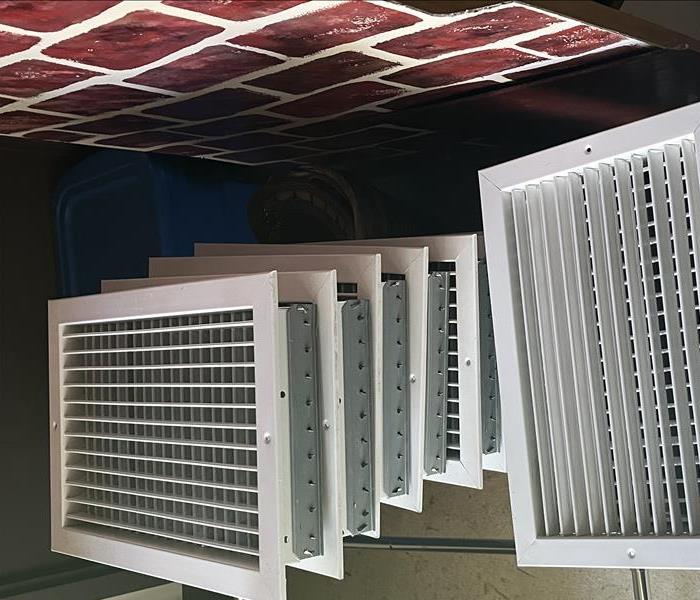 We’ll explore why certified experts are essential for effective and safe restoration.
We’ll explore why certified experts are essential for effective and safe restoration.
Experiencing a fire in your home or business in Gainesville, FL, is a devastating event. The aftermath involves not only dealing with the emotional toll but also addressing the physical damage left behind. This is where the importance of hiring certified professionals for fire damage restoration comes into play. In this blog, we’ll explore why certified experts are essential for effective and safe restoration.
Expertise and Specialized Training
Comprehensive Knowledge
Certified fire damage restoration professionals have undergone extensive training to understand the complexities of fire damage. They are knowledgeable about the different types of fire damage, the behavior of smoke, and the best methods for cleaning and restoring various materials. This expertise ensures that all aspects of the damage are thoroughly addressed.
Use of Advanced Techniques and Equipment
Certified professionals use state-of-the-art equipment and techniques to restore fire-damaged properties. From thermal foggers and ozone machines to advanced cleaning agents, these tools are designed to effectively remove soot, smoke, and odors. This advanced approach not only restores your property but also prevents secondary damage, such as corrosion and mold growth.
Ensuring Safety and Compliance
Adherence to Industry Standards
Hiring certified professionals means that the restoration process adheres to industry standards and regulations. This compliance is crucial for ensuring the safety of the building’s occupants and the structural integrity of the property. Certified experts follow protocols set by organizations like the Institute of Inspection, Cleaning and Restoration Certification (IICRC), which guarantees high-quality and safe restoration work.
Proper Handling of Hazardous Materials
Fire damage often involves hazardous materials, such as asbestos and lead, especially in older buildings. Certified professionals are trained to handle these materials safely, ensuring that they are removed and disposed of according to legal and environmental guidelines. This protects both the occupants and the environment from potential harm.
Efficient and Thorough Restoration
Speedy and Effective Response
Certified fire damage restoration experts understand the urgency of addressing fire damage. They respond quickly to mitigate further damage and begin the restoration process. Their efficiency minimizes the time your property remains uninhabitable, allowing you to return to normalcy sooner.
Comprehensive Restoration Services
From initial assessment and cleaning to repairs and final inspections, certified professionals offer comprehensive restoration services. They address all areas of damage, including structural repairs, smoke and soot removal, odor elimination, and water damage restoration. This thorough approach ensures that your property is fully restored to its pre-fire condition.
Peace of Mind for Property Owners
Insurance Coordination
Dealing with insurance claims after a fire can be overwhelming. Certified fire damage restoration professionals often assist with the claims process, providing detailed documentation and working directly with insurance companies. This support can expedite your claim and ensure you receive the coverage you need for the restoration work.
Guaranteed Quality and Accountability
Certified professionals stand by their work, offering guarantees and warranties on their services. This accountability provides peace of mind, knowing that the restoration is being handled by qualified experts committed to delivering the best results.
Conclusion
Hiring certified professionals for fire damage restoration is crucial for ensuring a safe, efficient, and thorough recovery process. Their expertise, adherence to industry standards, and comprehensive services make them the best choice for restoring your property to its pre-fire condition. Trust SERVPRO® for certified fire damage restoration services that provide peace of mind and high-quality results. Contact us today to learn more about our expert restoration solutions.
DIY Mold Removal: Knowing When to Call in the Professionals
7/10/2024 (Permalink)
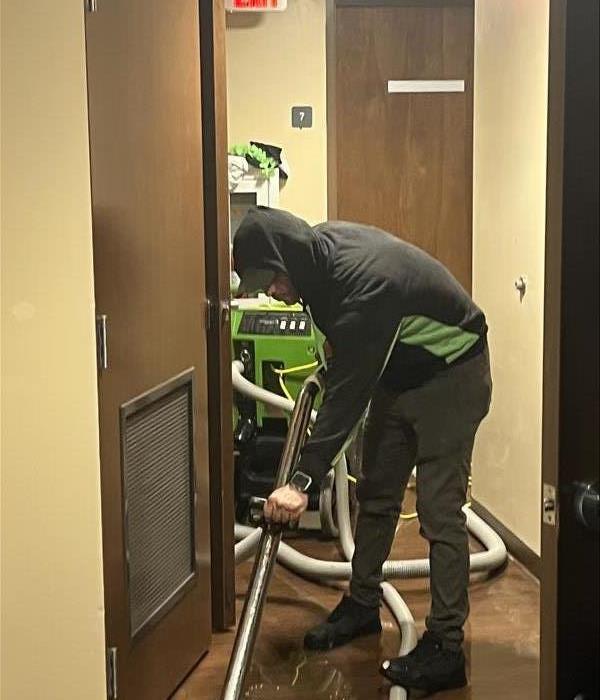 Explore DIY mold removal strategies and discuss when it's time to enlist the help of SERVPRO!
Explore DIY mold removal strategies and discuss when it's time to enlist the help of SERVPRO!
Dealing with mold growth in your home can be a daunting task, and many homeowners are tempted to tackle the problem themselves through DIY mold removal methods. While some minor mold issues can be addressed using DIY techniques, there are instances where calling in professionals is the safest and most effective course of action. In this blog post, we'll explore DIY mold removal strategies and discuss when it's time to enlist the help of professional mold remediation experts.
DIY Mold Removal Methods
Surface Cleaning:
For minor mold growth on non-porous surfaces such as tile, glass, or plastic, surface cleaning with household cleaners and disinfectants can be effective. Solutions such as vinegar, hydrogen peroxide, or commercial mold cleaners can help remove mold stains and inhibit regrowth.
Removal of Moldy Materials:
If mold has infiltrated porous materials such as drywall, carpet, or upholstery, the affected materials may need to be removed and replaced. DIY removal of moldy materials may be feasible for small-scale projects, but larger or extensive mold infestations may require professional assistance.
Improving Ventilation and Moisture Control:
Addressing underlying moisture issues and improving ventilation in areas prone to mold growth can help prevent future mold problems. DIY measures such as installing exhaust fans, fixing leaks, and using dehumidifiers can help reduce moisture levels and inhibit mold growth.
When to Call the Professionals
Extensive Mold Growth:
If mold growth covers a large area (typically more than 10 square feet), or if mold is present in multiple rooms or levels of your home, it's best to seek professional assistance. Professional mold remediation experts have the training, experience, and equipment to safely and effectively address large-scale mold infestations.
Hidden Mold:
Mold can often lurk in hidden or inaccessible areas such as behind walls, under flooring, or within HVAC systems. If you suspect mold is present but cannot locate the source, or if mold growth is visible in hard-to-reach areas, professional mold inspection and remediation services are recommended.
Structural Damage:
Mold growth can cause structural damage to your home if left unchecked. Signs of structural damage, such as warped or deteriorating building materials, indicate a serious mold problem that requires professional intervention to assess and address.
While DIY mold removal methods may be suitable for minor mold issues, there are situations where professional mold remediation services are necessary to ensure thorough and effective removal of mold and prevent its recurrence. By knowing when to call in the professionals, homeowners can protect their property and maintain a healthy indoor environment. If you're unsure about how to address mold growth in your home or if you're dealing with a large-scale mold infestation, don't hesitate to contact a reputable restoration company like SERVPRO® for expert assessment and remediation services.
Restoring Personal Items with Sentimental Value After Water Damage
6/18/2024 (Permalink)
Water damage can wreak havoc on a home, causing destruction to belongings and cherished personal items. While the loss of possessions can be devastating, it's often the sentimental items that hold the most value. Family heirlooms, photographs, and keepsakes carry memories and stories that cannot be replaced. However, with prompt action and proper restoration techniques, many water-damaged personal items can be salvaged and restored to their former glory. In this blog, we'll explore the process of restoring personal items with sentimental value after water damage and the emotional significance of preserving these treasures.
The Emotional Impact of Water Damage
Experiencing water damage in your home can be a traumatic and emotional experience, especially when cherished belongings are affected. Sentimental items such as family photos, heirlooms, and mementos carry memories and connections to loved ones, making their loss feel particularly devastating. However, while the damage may seem irreversible, there are often restoration options available to salvage these precious possessions.
Steps for Restoring Water-Damaged Personal Items
- Assess the Damage: The first step in restoring water-damaged personal items is to assess the extent of the damage. Carefully inspect each item to determine the type of damage and the best course of action for restoration.
- Act Quickly: Time is of the essence when dealing with water-damaged items. The longer belongings remain wet, the greater the risk of irreversible damage and mold growth. Act quickly to remove items from the water, and begin the restoration process as soon as possible.
- Handle with Care: When handling water-damaged items, it's essential to do so with care to avoid further damage. Handle items gently and avoid rubbing or scrubbing, as this can cause additional harm.
- Dry Thoroughly: Proper drying is crucial for preventing further damage and mold growth. Lay items flat to air dry, or use fans and dehumidifiers to expedite the drying process. Avoid exposing items to direct sunlight or high heat, as this can cause further damage.
- Clean and Disinfect: Once items are dry, clean and disinfect them to remove any remaining dirt, debris, or contaminants. Use gentle cleaning solutions and soft brushes to avoid causing damage to delicate surfaces.
- Seek Professional Help: For valuable or delicate items, such as artwork, photographs, or textiles, consider seeking professional restoration services. Restoration experts have the knowledge, skills, and specialized equipment necessary to safely restore water-damaged items.
- Preserve and Protect: After restoration, take steps to preserve and protect your restored items. Store them in a dry, climate-controlled environment away from moisture and humidity. Use acid-free storage materials to prevent deterioration over time.
The Importance of Sentimental Value
While the physical restoration of water-damaged items is essential, it's equally important to acknowledge the emotional significance of these possessions. Sentimental items carry memories, stories, and connections to loved ones, making their preservation invaluable. Restoring these treasures not only preserves their physical integrity but also honors the emotional value they hold for individuals and families.
Water damage can pose a significant threat to cherished personal items, but with prompt action and proper restoration techniques, many possessions can be salvaged and restored. The emotional significance of sentimental items cannot be overstated, making their preservation a priority in the aftermath of water damage. By taking swift action, handling items with care, and seeking professional restoration when needed, homeowners can restore their cherished possessions and preserve the memories they hold for generations to come.
The Vital Role of Rapid Response in Storm Damage Restoration
5/21/2024 (Permalink)
Storms can wreak havoc on homes and communities, leaving behind a trail of destruction in their wake. From powerful hurricanes to sudden tornadoes and severe thunderstorms, these natural disasters can cause extensive damage to property, infrastructure, and the environment. In such turbulent times, the importance of rapid response in storm damage restoration cannot be overstated. In this blog, we'll delve into why swift action is crucial in mitigating the impact of storm damage and facilitating the restoration process.
The Urgency of Swift Action
- Prevent Further Damage: After a storm, time is of the essence in preventing secondary damage to your property. Water intrusion, for example, can lead to mold growth, structural weakening, and electrical hazards if left unchecked. By acting swiftly, you can minimize the extent of the damage and reduce repair costs.
- Ensure Safety: Storm-damaged structures pose significant safety risks to occupants and restoration professionals. Structural instability, electrical hazards, and contaminated water can all jeopardize safety. A rapid response allows for immediate assessment and mitigation of safety hazards, protecting lives and property.
- Salvage Possessions: Personal belongings and valuable assets may sustain damage during a storm. Rapid intervention enables restoration professionals to salvage as much as possible, whether through drying out water-damaged items, cleaning and disinfecting, or implementing specialized restoration techniques.
- Expedite the Restoration Process: The longer storm damage lingers unresolved, the more extensive and time-consuming the restoration process becomes. Rapid response teams are equipped with the necessary tools, expertise, and resources to expedite restoration efforts, minimizing disruption to your life and enabling you to return to normalcy sooner.
Components of Rapid Response
- Emergency Assessment: Immediately following a storm, restoration professionals conduct a thorough assessment of the damage to your property. This assessment helps prioritize restoration tasks and identify safety hazards that require immediate attention.
- Mitigation Measures: Mitigation measures are implemented promptly to prevent further damage and protect your property. This may include tarping and boarding up damaged areas, extracting standing water, and stabilizing structures to prevent collapse.
- Restoration Planning: A comprehensive restoration plan is developed based on the assessment findings. This plan outlines the necessary steps, timeline, and resources required to restore your property to its pre-storm condition.
- Skilled Team Deployment: A skilled and experienced restoration team is deployed to execute the restoration plan efficiently. These professionals are trained to handle various aspects of storm damage restoration, from structural repairs to water extraction and mold remediation.
- Continuous Monitoring: Throughout the restoration process, ongoing monitoring ensures that progress is tracked, and any emerging issues are addressed promptly. This proactive approach helps maintain momentum and ensures that restoration efforts stay on track.
In the aftermath of a storm, rapid response is indispensable in mitigating the impact of damage and expediting the restoration process. By acting swiftly, restoration professionals can prevent further damage, ensure safety, salvage possessions, and expedite the restoration process. If your property has been affected by a storm, don't hesitate to seek out a reputable restoration company that prioritizes rapid response. Remember, time is of the essence when it comes to storm damage restoration, and swift action can make all the difference in restoring your property and peace of mind.
Warming Up Wisely: Navigating the Dangers of Space Heaters Safely
4/11/2024 (Permalink)
Space heaters, compact and convenient, have become go-to solutions for individuals seeking extra warmth in specific areas of their homes. While these devices offer comfort, it's essential to acknowledge and address the potential dangers associated with their use. In this blog, we'll explore the risks of space heaters and provide guidelines on how to use them safely to keep your cozy retreat from becoming a fire hazard.
Understanding the Risks
Fire Hazard
- Space heaters can pose a significant fire risk if used improperly. Flammable materials such as curtains, bedding, and furniture can easily catch fire if they come into contact with the heater.
- Electrical Issues
- Overloading circuits or using damaged extension cords can lead to electrical problems, increasing the risk of fire. Regularly inspect your space heater's power cord and plug for any signs of wear or damage.
- Carbon Monoxide Poisoning
- Space heaters that burn fuel can produce carbon monoxide, a colorless and odorless gas that can be deadly. It's crucial to use fuel-burning heaters in well-ventilated areas and never leave them on overnight.
- Tip-Over Accidents
- Space heaters, especially older models, may lack safety features such as automatic shut-off when tipped over. Accidental knocks or bumps can lead to the heater tipping over and causing a fire.
Using Space Heaters Safely
- Choose the Right Heater
- Select a space heater with built-in safety features such as automatic shut-off if it overheats or tips over. Look for a model that meets safety standards and has a label from a recognized testing laboratory.
- Maintain Clearance
- Keep a clear space of at least three feet around the heater. Avoid placing heaters near flammable materials like curtains, bedding, or furniture, and never use them to dry clothes.
- Plug Directly into Outlets
- Plug your space heater directly into an outlet and avoid using extension cords, as they can overheat. If you must use an extension cord, choose a heavy-duty one capable of handling the heater's power load.
- Regular Inspections
- Inspect your space heater regularly, checking for any signs of damage to the cord, plug, or heating elements. If you notice any issues, discontinue use and seek professional repair or replacement.
- Use the Right Fuel
- If you're using a fuel-burning space heater, ensure you're using the correct fuel recommended by the manufacturer. Never use substitute fuels or attempt to modify the heater for a different type of fuel.
- Ventilate Properly
- If you're using a fuel-burning heater, ensure proper ventilation to prevent the buildup of carbon monoxide. Use these heaters in well-ventilated areas, and never leave them on while sleeping.
- Supervise and Turn Off
- Never leave a space heater unattended. Turn it off when you leave the room or go to sleep, and supervise its use when it's operational.
- Educate Household Members
- Ensure that everyone in your household is aware of the proper use and potential risks of space heaters. Discuss safety guidelines and emphasize the importance of responsible usage.
While space heaters offer a cozy solution to chilly days, understanding and respecting their potential dangers is crucial. By following safety guidelines, choosing the right model, and using these devices responsibly, you can enjoy the warmth without compromising your home's safety. Stay warm, stay safe, and make your cozy retreat a secure haven for all seasons.
 Dive into the expert steps for restoring roofing and gutters after a fire, helping you understand why professional restoration is essential.
Dive into the expert steps for restoring roofing and gutters after a fire, helping you understand why professional restoration is essential.

 24/7 Emergency Service
24/7 Emergency Service




